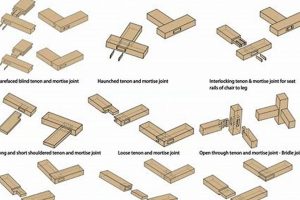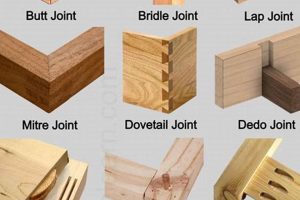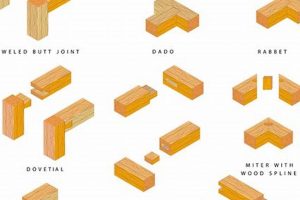An interlocking method joins two pieces of wood, characterized by a series of ‘tails’ cut into one board which interlock with corresponding ‘pins’ cut into another. This strong and visually appealing technique has been a staple in cabinetry and furniture construction for centuries, offering superior resistance to pulling forces.
The employment of this joinery method provides significant structural integrity, making it ideal for applications where strength and durability are paramount. Its historical prevalence showcases its effectiveness and aesthetic value, contributing to both the functional longevity and visual appeal of crafted items. It reflects quality and craftsmanship.
The subsequent sections will delve into the various types of this specific connection, examine the tools and techniques required for its creation, and explore practical applications within diverse woodworking projects, covering both hand-cut and machine-cut methods.
Expert Advice
Achieving precise and robust connections requires meticulous planning and execution. These guidelines outline key considerations for successful implementation.
Tip 1: Wood Selection: Utilize hardwoods like maple or cherry for increased joint strength. Softwoods may compress and compromise the integrity of the connection.
Tip 2: Accurate Marking: Employ sharp marking knives and precise measurement tools. Errors in marking will accumulate and negatively impact the final fit.
Tip 3: Consistent Cutting: Maintain a steady hand and consistent saw angle. Deviations will result in gaps and weakened holding power.
Tip 4: Proper Chisel Technique: Use sharp chisels and controlled paring motions. Avoid excessive force that can damage the wood fibers.
Tip 5: Dry Fitting: Always dry-fit components before applying adhesive. This allows for adjustments and ensures proper alignment.
Tip 6: Grain Direction: Pay attention to wood grain direction to ensure the joint resists stress effectively. Align grain for optimal strength.
Tip 7: Glue Application: Apply a thin, even layer of high-quality wood glue to all mating surfaces. Avoid excess glue, which can weaken the bond.
Tip 8: Clamping Pressure: Use appropriate clamping pressure to ensure a tight fit. Avoid over-clamping, which can distort the wood.
Adherence to these techniques ensures a durable and aesthetically pleasing result, enhancing the value and longevity of woodworking projects.
The following conclusion will summarize the key benefits and applications of this valuable joinery method.
1. Strength
The structural strength afforded by a dovetail joint is a primary reason for its enduring presence in woodworking. The interlocking arrangement of tails and pins creates a mechanical bond that resists tensile forces pulling the joint apart. Unlike simple butt joints relying solely on adhesive, the geometry of a dovetail resists separation even under significant stress. This intrinsic resistance to pulling forces makes it particularly suitable for constructing drawers, boxes, and other structures subjected to repeated stress and load-bearing requirements.
A visible example of this inherent strength can be observed in antique furniture where dovetail joints have remained intact and functional for centuries. The longevity of these joints highlights the effectiveness of the design in resisting degradation and maintaining structural integrity over prolonged periods. Further examples are the use of dovetails in tool chests and workbenches, showcasing their capacity to withstand heavy loads and frequent movement without compromising the overall structure. The strength directly impacts the lifespan and reliability of the object.
Understanding the relationship between the joint’s construction and its load-bearing capacity is critical for woodworkers selecting appropriate joinery methods. Recognizing the limitations and advantages of different dovetail variations allows for informed decisions regarding material selection, joint design, and overall construction techniques. While skill and precision are essential for producing aesthetically pleasing joints, a clear grasp of their inherent strength ensures a durable and long-lasting outcome, regardless of the complexity or scale of the project.
2. Precision
The successful execution of joinery relies heavily on precision. Dimensional accuracy in marking, cutting, and fitting directly determines the joint’s structural integrity and aesthetic appeal. Deviations from precise measurements compromise the tightness of the interlock, reducing the joint’s ability to resist tensile forces. Inaccurate cuts lead to gaps and uneven surfaces, negatively affecting both the visual appearance and the overall strength of the assembled piece. Therefore, precision is not merely a desirable attribute but a fundamental requirement for creating functional and visually pleasing examples of this type of joint.
Real-world examples illustrate the importance of dimensional control. Consider the construction of a drawer box. If the tails and pins are not precisely aligned and cut, the resulting joint will be weak and prone to separation under repeated use. This imprecision leads to a drawer that is difficult to open and close, eventually failing altogether. Similarly, in fine cabinetry, even minor discrepancies in joint fitting are readily apparent, detracting from the overall quality and value of the piece. The tight, seamless fit achieved through careful measurements and cutting is a hallmark of expert craftsmanship and a demonstration of the direct relationship between accuracy and quality.
Achieving the necessary level of precision presents a significant challenge, requiring specialized tools, practiced techniques, and a meticulous approach to the woodworking process. Factors such as wood movement, saw kerf, and chisel control must be carefully considered and managed to minimize errors. While advanced machinery can aid in achieving consistent results, mastery of hand tools and traditional methods remains crucial for adapting to unique situations and ensuring the highest degree of accuracy. This level of exactness is imperative to ensure the durability and visual perfection.
3. Aesthetics
The visual appeal constitutes a significant aspect of this joinery method. Beyond mere structural functionality, the pattern created by the interlocking pins and tails offers a distinctive design element. The exposed joint becomes a visual statement, showcasing the quality of craftsmanship and adding a decorative flourish to the piece. The deliberate inclusion of this joint serves not only to unite the wood components but also to enhance the overall aesthetic impression.
Consider, for example, the drawers of antique chests or fine furniture. The visible dovetails are often intentionally highlighted, serving as a mark of quality and attention to detail. Their presence elevates the perceived value of the piece, signaling skilled handwork and a commitment to superior construction methods. Furthermore, contemporary designers frequently incorporate this joint into exposed elements of furniture to achieve a modern yet handcrafted aesthetic, underscoring its enduring appeal across various design styles. In some cases, contrasting wood species are used to accentuate the visual pattern created by the tails and pins, further emphasizing their decorative role.
Ultimately, a well-executed joint blends seamlessly with the overall design, enhancing its visual harmony. It transforms a structural necessity into an artistic expression, reflecting the maker’s skill and dedication to both form and function. The careful selection of wood species, precise cutting, and meticulous finishing contribute to the aesthetic impact, elevating the object from a purely utilitarian item to one possessing intrinsic artistic value. Therefore, aesthetics remains a critical component in assessing the overall quality and desirability of woodwork employing this technique.
4. Interlocking
The concept of interlocking is intrinsic to understanding the fundamental nature and superior strength of joinery. It is the defining characteristic that distinguishes this technique from simpler joining methods and contributes significantly to its widespread use in woodworking applications requiring robust and durable connections.
- Mechanical Bond Formation
The interlocking mechanism, achieved through precisely shaped tails and pins, creates a mechanical bond that resists separation. This bond does not rely solely on adhesive, but instead on the physical engagement of the wood fibers, resulting in a joint that can withstand significant tensile forces. Examples include drawer fronts resisting being pulled from the drawer box, and cabinet carcases maintaining structural integrity under heavy loads.
- Stress Distribution
The design of the joint facilitates the distribution of stress across the entire surface area of the connection. The tails and pins act as anchors, dispersing forces evenly and preventing stress concentration at any single point. This even distribution enhances the joint’s overall strength and resistance to failure. Examples can be observed in large casework, where the stress of supporting heavy items is distributed along the dovetails, ensuring stability and preventing warping or cracking.
- Geometric Constraint
The interlocking configuration provides geometric constraint, preventing movement in multiple directions. The tails and pins not only resist pulling forces but also resist racking or twisting, contributing to the overall stability of the structure. A common illustration is in the corners of boxes or chests, where this prevents the sides from skewing, ensuring that they remain square and aligned.
- Surface Area Maximization
The complex shape increases the bonding surface area compared to simple butt joints. This expanded area allows for more effective adhesive application, further strengthening the connection. The increase in surface area is advantageous in applications where long-term stability is critical, as it provides a more secure and durable bond. Examples are found in the construction of musical instruments, where the stability of the joints is paramount to the instrument’s sound quality and longevity.
These interlocking principles demonstrate the enduring value. By understanding how the components mechanically engage, distribute stress, provide geometric constraint, and maximize surface area, woodworkers can appreciate the ingenuity and effectiveness of this time-honored joint.
5. Durability
The characteristic of durability is intrinsically linked to the successful application of joinery. The inherent strength of the interlocking design, when executed with precision and appropriate materials, results in a joint that resists failure over extended periods. This resistance to wear and tear makes it a desirable choice for projects intended to withstand repeated stress or environmental factors. The longevity observed in antique furniture employing the joints serves as tangible evidence of its long-term reliability. The use of specific hardwood species, combined with a well-fitted joint, directly contributes to an increased lifespan, reducing the likelihood of structural compromise and maintaining functional integrity throughout its use.
Examples of joinery’s contribution to product lifespan are numerous. In drawer construction, the resistance to pulling forces prevents separation under the stress of repeated opening and closing. In cabinet making, the enduring bond ensures structural stability, preventing warping or collapse even when subjected to heavy loads. The choice to employ in furniture destined for high-traffic environments, such as libraries or public spaces, reflects a conscious decision to prioritize long-term performance and minimize maintenance costs. Therefore, the initial investment in skilled craftsmanship and quality materials yields a significant return in terms of reduced repair needs and extended product lifespan.
Ultimately, the selection of is a strategic decision rooted in a commitment to product quality and longevity. While other joining methods may offer ease of construction or reduced material costs, they often lack the durability inherent in the interlocking design. Understanding the causal relationship between meticulous joint construction, appropriate material selection, and long-term performance enables woodworkers to make informed decisions, ensuring that the finished product meets the demands of its intended application and provides lasting value to its user. The durability that results from careful consideration of these factors distinguishes superior craftsmanship and contributes to the enduring legacy of woodworking.
6. Craftsmanship
The connection between craftsmanship and joinery is profound. Skill and precision in execution are not merely desirable attributes but essential components of a successful, functional and durable joint. The tightness of fit, the clean lines of the cuts, and the overall visual appeal are direct reflections of the woodworker’s expertise and dedication. Consider antique furniture, where the well-executed joints serve as a testament to the maker’s artistry, demonstrating a mastery of technique that has endured for generations. It is the craftsmanship that elevates from a simple structural element to a mark of quality and a decorative feature, adding value and character to the finished piece.
The relationship between craftsmanship and the joint extends beyond aesthetics. The accuracy of the cuts directly impacts the strength and stability of the joint. Imperfectly fitted pins and tails compromise the mechanical bond, diminishing its ability to resist tensile forces and reducing its overall lifespan. Examples of this cause-and-effect relationship can be observed in poorly made drawers, where the joints fail prematurely due to inadequate craftsmanship, leading to structural weakness and functional impairment. Skilled craftsmanship, in contrast, ensures that the joint performs optimally, contributing to the longevity and reliability of the piece as a whole. This interplay is critical for all applications, from fine furniture making to structural carpentry.
Understanding the importance of craftsmanship in executing is crucial for both woodworkers and consumers. Recognizing the signs of quality craftsmanship enables informed decisions about material selection, joint design, and construction techniques. While modern machinery can assist in achieving precise cuts, it cannot replace the skill and judgment of an experienced woodworker. Appreciating the value of craftsmanship ensures that the joint is not only functional but also aesthetically pleasing, serving as a lasting symbol of the dedication and expertise that went into its creation. The pursuit of excellence in craftsmanship, therefore, remains a cornerstone of woodworking practice, enriching both the process and the outcome.
7. Wood Selection
Wood selection exerts a considerable influence on the structural integrity and longevity of joinery. The inherent properties of different wood species, such as hardness, density, and grain orientation, directly affect the joint’s ability to withstand stress and resist deformation. A dense, close-grained hardwood, for instance, will generally provide a stronger and more durable joint compared to a softwood. The choice of material is a primary determinant of the joint’s capacity to perform its intended function effectively and resist degradation over time. For example, using maple or oak for cabinet drawers enhances their durability when subjected to repeated opening and closing. Conversely, employing pine might lead to premature failure.
Specific wood characteristics play a critical role in achieving a tight, lasting fit. Wood with minimal seasonal movement minimizes the risk of the joint loosening or cracking due to fluctuations in humidity. Straight, consistent grain patterns facilitate accurate cutting and fitting of the tails and pins, ensuring optimal surface contact and glue adhesion. Furthermore, resistance to splitting or splintering during the cutting process is an important consideration, as it directly impacts the precision and cleanliness of the finished joint. An illustration is the use of cherry, prized for its stability and fine grain, often selected for high-end furniture where aesthetics and long-term performance are valued. This is in contrast to using a wood that easily splinters, which would compromise both the structural integrity and the aesthetic appeal of the joint.
Therefore, understanding the relationship between wood properties and joint performance is essential for informed decision-making in woodworking. The selection of an appropriate species requires careful consideration of the intended application, environmental conditions, and aesthetic preferences. Failure to account for these factors can result in a compromised joint, diminished product lifespan, and ultimately, a less satisfactory outcome. Skilled woodworkers recognize the significance of this connection and prioritize material selection as a critical step in the creation of lasting, high-quality pieces. The joint’s success depends in large part on the wood it is crafted from.
Frequently Asked Questions
The following addresses common inquiries regarding the nature, application, and creation of this joint. The information presented aims to clarify misconceptions and provide accurate insights.
Question 1: What distinguishes joinery from other wood joining methods?
Unlike methods relying primarily on fasteners or adhesives, joinery employs an interlocking design. This mechanical interlock provides superior resistance to tensile forces, making it ideal for applications demanding structural integrity.
Question 2: Is joinery solely for decorative purposes?
While visually appealing, the primary function of the joint is structural. The exposed joint can enhance aesthetics, but its inherent strength and durability are its core attributes.
Question 3: Can be created using power tools?
While traditionally hand-cut, this joint can be efficiently produced using specialized power tools like routers and dovetail jigs. However, achieving optimal precision and fit often necessitates hand finishing.
Question 4: What wood species are best suited for joinery?
Hardwoods such as maple, oak, and cherry are generally preferred due to their density and resistance to wear. Softwoods can be used, but may require careful selection and reinforcement to ensure adequate strength.
Question 5: How does wood movement affect joinery?
Wood expands and contracts with changes in humidity. Proper joint design and wood selection must account for this movement to prevent cracking or loosening over time.
Question 6: Is skilled labor required to create robust joinery?
Yes. Expertise in marking, cutting, and fitting is essential for achieving optimal strength and aesthetic appeal. While some techniques can be learned relatively quickly, mastering the intricacies requires practice and attention to detail.
This FAQ provides a foundational understanding. Further exploration of specific techniques and applications is recommended for comprehensive knowledge.
The next section will delve into practical applications within woodworking projects.
Conclusion
This exploration has illuminated the multifaceted nature of woodwork dovetail joints, underscoring their significance as a testament to both structural integrity and aesthetic refinement in woodworking. The interlocking design, precision requirements, material considerations, and demand for skilled craftsmanship have been examined, demonstrating how these elements converge to produce a joint of enduring value. The joint’s long history and continued relevance in modern woodworking attest to its effectiveness and versatility.
As woodworking continues to evolve, the fundamental principles embodied by woodwork dovetail jointsstrength, precision, and aesthetic considerationremain paramount. Further investigation and mastery of these techniques are encouraged, ensuring the perpetuation of this time-honored tradition and contributing to the creation of enduring, high-quality pieces that stand the test of time. Continued adherence to best practices ensures its ongoing relevance in craft and industry.







![Woodworking's Edge: What is a Jointer for? [Explained] Step-by-Step Guides, Tools & Inspiration to Build Beautiful Wooden Decor on a Budget Woodworking's Edge: What is a Jointer for? [Explained] | Step-by-Step Guides, Tools & Inspiration to Build Beautiful Wooden Decor on a Budget](https://woodfromhome.com/wp-content/uploads/2025/11/th-553-300x200.jpg)